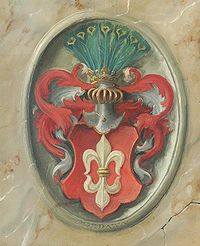Portal:Heraldry
Welcome to the Heraldry and Vexillology Portal!


Heraldry encompasses all of the duties of a herald, including the science and art of designing, displaying, describing and recording coats of arms and badges, as well as the formal ceremonies and laws that regulate the use and inheritance of arms. The origins of heraldry lie in the medieval need to distinguish participants in battles or jousts, whose faces were hidden by steel helmets.
Vexillology (from the Latin vexillum, a flag or banner) is the scholarly study of flags, including the creation and development of a body of knowledge about flags of all types, their forms and functions, and of scientific theories and principles based on that knowledge. Flags were originally used to assist military coordination on the battlefield, and have evolved into a general tool for signalling and identification, particularly identification of countries.
Selected article

Swedish heraldry refers to the cultural tradition and style of heraldic achievements in modern and historic Sweden. It belongs culturally to the German-Nordic heraldic tradition, noted for its multiple helmets and crests which are treated as inseparable from the shield, repetition of colours and charges between the shield and the crest, and its scant use of heraldic furs. Swedish heraldry is similar to Danish heraldry; both were heavily influenced by German heraldry. The medieval history of the Nordic countries was closely related, so they developed their heraldic individuality rather late. Swedish and Finnish heraldry have a shared history prior to the Diet of Porvoo in 1809. Unlike the macaronic and highly stylized English blazon, Swedish heraldry is described in plain language, using only Swedish terminology.
In Sweden today, the official coats of arms of corporations and government offices are protected by Swedish law, if the coat of arms is registered with the Swedish Patent and Registration Office. Heraldic arms of common citizens (burgher arms), however, are less strictly controlled; these are recognised by inclusion in the annually published Scandinavian Roll of Arms. (more...)
Selected biography

John Anstis (29 August 1669–4 March 1744) was an English officer of arms and antiquarian. He rose to the highest heraldic office in England and became Garter King of Arms in 1718 after years of plotting. Anstis was born at St Neot, Cornwall on 29 August 1669. He was the first son of another John Anstis and his wife Mary, the daughter of George Smith. Anstis matriculated at Exeter College, Oxford, on 27 March 1685 and entered the Middle Temple on 31 January 1690. On 23 June 1695 he married Elizabeth, daughter and heir of Richard Cudlipp of Tavistock, Devon. They had eight sons and six daughters. (more...)
Selected flag

The flag of Hong Kong, or the Regional Flag of the Hong Kong Special Administrative Region of the People's Republic of China, features a stylised, white, five-petal Bauhinia blakeana flower in the centre of a red field. The flag was adopted on 16 February 1990. On 10 August 1996, it received formal approval from the Preparatory Committee, a group which advised the People's Republic of China (PRC) on the transfer of sovereignty over Hong Kong from the United Kingdom to the PRC in 1997. The flag was first officially hoisted on 1 July 1997, in the handover ceremony marking the transfer of sovereignty. The precise use of the flag is regulated by laws passed by the 58th executive meeting of the State Council held in Beijing. The design of the flag is enshrined in Hong Kong's Basic Law, the city's constitutional document, and regulations regarding the use, prohibition of use, desecration, and manufacture of the flag are stated in the Regional Flag and Regional Emblem Ordinance. (more...)
Selected picture

Oil painting (2005) of the Coat of arms of Gozdawa. In Polish heraldry each coat of arms has its own name and may be shared by several unrelated families.
Did you know...
- ...that the Alamogordo Museum of History owns a rare 47-star U.S. flag, thought to have been made in 1912 to celebrate the entry of New Mexico into the United States?
- ...that British officer of arms Sir William Henry Weldon was the owner of a circus?
- ...that in Scottish heraldry, slogans may appear above a crest or coat of arms, or below a main motto?
- ...that Togolese painter and sculptor Paul Ahyi, who designed the flag of Togo, was inducted as a UNESCO Artist for Peace in 2009?
- ...that some of the reliquaries for books called cumdachs were carried into battle as standards in Medieval Ireland?
Related portals
|
|
|
Heraldry Web resources
Authorities
- Belgium - The Council of Nobility, Flemish Heraldic Council and Council of Heraldry and Vexillology of the French Community
- Canada - Canadian Heraldic Authority and see also Public Register of Arms, Flags and Badges
- England, Wales, and Northern Ireland - The College of Arms
- Ireland - The Office of the Chief Herald of Ireland
- Netherlands - High Council of Nobility
- Portugal - Instituto da Nobreza Portuguesa
- Scotland - The Court of the Lord Lyon
- South Africa - South African Bureau of Heraldry
- Sweden - National Board of Heraldry, The National Archive
- United States Army - The United States Army Institute of Heraldry
Societies
- Greek Heraldry Society
- The Academy of Heraldic Science Czech republic
- The American College of Heraldry
- The American Heraldry Society
- The Augustan Society
- The Australian Heraldry Society Inc.
- Bulgarian Heraldry and Vexillology Society
- The Center for Research of Orthodox Monarchism
- Cambridge University Heraldic and Genealogical Society
- Chiltern Heraldry Group
- The College of Dracology
- Croatian Heraldic and Vexillologic Association
- The Finnish Heraldic Society
- Fryske Rie foar Heraldyk
- Hellenic Armigers Society
- Guild of Heraldic Artists
- Genealogical Society of Ireland
- Heraldry Research Institute (Japan)
- The Heraldry Society
- The Heraldry Society of Africa
- The Heraldry Society of New Zealand Inc.
- The Heraldry Society of Scotland
- The Heraldry Society of Southern Africa
- The Institute of Heraldic and Genealogical Studies
- The International Association of Amateur Heralds
- Italian Center of Vexillological Studies
- Lancashire Heraldry Group
- Macedonian Heraldry Society
- New England Historic Genealogical Society Committee on Heraldry
- Norwegian Heraldry Society
- Oxford University Heraldry Society
- Polish Heraldry Society
- Polish Nobility Confederation
- Real Academia Matritense de Heráldica y Genealogía - Royal Academy of Heraldry and Genealogy of Madrid
- Romanian Institute for Genealogy and Heraldry
- The Royal Heraldry Society of Canada
- The Russian College of HeraldryThe Russian College of Heraldry
- Serbian Heraldic Society
- Societas Heraldica Scandinavica
- Societas Heraldica Slovenica
- Swedish Heraldic Society
- Ukrainian Heraldry Society
- Royal Association Genealogical and Heraldic Office of Belgium
Vexillology
Software
- Coat of Arms Visual Designer web-based program
- Puncher Heraldry Program
- Blazonry Server - pyBlazon
- DrawShield - creates SVG shield or arms image from blazon
- CoaMaker - web-based tool
- Blazon95 and BLAZONS! 2000, older Windows applications
Texts
- Heraldry, historical and popular : with seven hundred illustrations (1863)
- A Complete Guide to Heraldry (1909)
Other
Wikimedia
The following Wikimedia Foundation sister projects provide more on this subject:
-
Commons
Free media repository -
Wikibooks
Free textbooks and manuals -
Wikidata
Free knowledge base -
Wikinews
Free-content news -
Wikiquote
Collection of quotations -
Wikisource
Free-content library -
Wikispecies
Directory of species -
Wikiversity
Free learning tools -
Wikivoyage
Free travel guide -
Wiktionary
Dictionary and thesaurus












